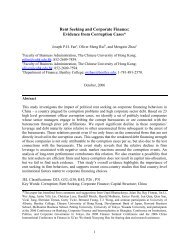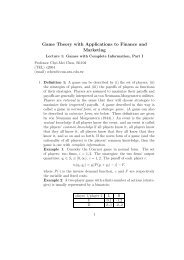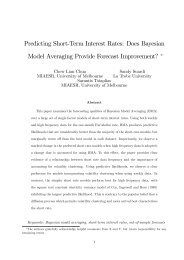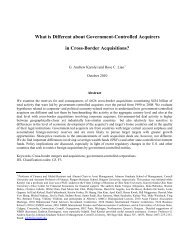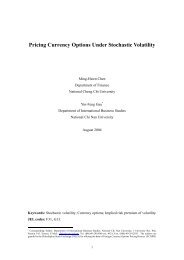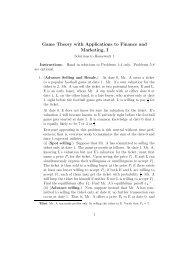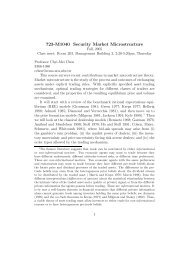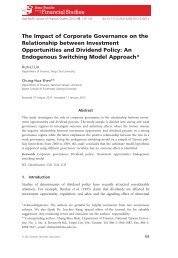Game Theory with Applications to Finance and Marketing
Game Theory with Applications to Finance and Marketing
Game Theory with Applications to Finance and Marketing
Create successful ePaper yourself
Turn your PDF publications into a flip-book with our unique Google optimized e-Paper software.
11. Because of proposition 2, we can show that<br />
Proposition 3. Every NE, denoted σ, is rationalizable.<br />
Proof. The I-tuple of sets { {σ 1 }, {σ 2 }, · · ·, {σ I } } satisfies the best<br />
response property <strong>and</strong> σ i ∈ {σ i }, ∀i, so that proposition 2 implies that<br />
for all i, σ i ∈ R i (Σ).<br />
12. An important connection between the rationalizable set of profiles <strong>and</strong><br />
the profiles surviving the iterated strict dominance is now given. In<br />
general, the former is contained in the latter.<br />
Proposition 4. In two-person finite games, the two concepts coincide.<br />
Proof. Suppose that σ i is not a best response <strong>to</strong> any element of Σ j ;<br />
i.e. for each σ j ∈ Σ j there exists b(σ j ) ∈ Σ i such that<br />
u i (b(σ j ), σ j ) > u i (σ i , σ j ).<br />
Call the original game Γ, <strong>and</strong> construct a zero-sum game Γ 0 as follows.<br />
The new game has the same set of players <strong>and</strong> pure strategy spaces,<br />
but the payoffs are defined as<br />
for all (σ ′ i, σ j ) ∈ Σ, <strong>and</strong><br />
u 0 i (σ ′ i, σ j ) ≡ u i (σ ′ i, σ j ) − u i (σ i , σ j )<br />
u 0 j(σ ′ i, σ j ) = −u 0 i (σ ′ i, σ j ).<br />
This game has an NE in mixed strategy. Let it be (σ ∗ i , σ ∗ j ). For any<br />
σ j ∈ Σ j , we have<br />
u 0 i (σ∗ i , σ j) ≥ u 0 i (σ∗ i , σ∗ j ) ≥ u0 i (b(σ∗ j ), σ∗ j )<br />
> u 0 i (σ i, σ ∗ j ) = 0,<br />
proving that σ i is strictly dominated by σ ∗ i . Thus a strategy for player<br />
i that can never be a best response against player j’s strategy must be<br />
strictly dominated from player i’s point of view. Define for the purpose<br />
of iterated deletion of strictly dominated strategies S 0 i = S i , Σ 0 i = Σ i ,<br />
<strong>and</strong> for all t ∈ Z + ,<br />
S t i ≡ {s i ∈ S t−1<br />
i<br />
: ∀σ i ∈ Σi<br />
t−1 , ∃s −i ∈ S−i t−1 , u i(s i , s −i ) ≥ u i (σ i , s −i )},<br />
11



